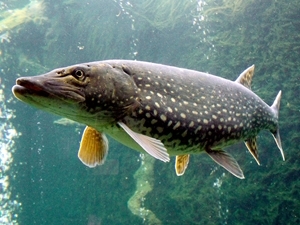Pike
 The pike (Esox lucius) is a freshwater fish found throughout the northern hemisphere, across America, Europe and Russia. It is prized by many who fish for them as they can grow very large and are renowned for their hard-fighting qualities when hooked.
The pike (Esox lucius) is a freshwater fish found throughout the northern hemisphere, across America, Europe and Russia. It is prized by many who fish for them as they can grow very large and are renowned for their hard-fighting qualities when hooked.
The British record is held by Roy Lewis who, in October 1992, caught a pike weighing in at 46lbs 13oz from Llandegfedd Reservoir in Monmouthshire, Wales. However, the European record is even bigger, as a pike weighing in at 55lb 1oz was caught in Grefeern, Germany, in 1986.
Pike are sublime predators and seem to have changed very little from the pike fossil remains found in the Cromer Forest fossil beds, dated to some 500,000 years ago. The word pike seems to be derived from the French ‘pique’, meaning spear. This gives a clue as to how this predator hunts. It will lie in wait amongst vegetation, using its olive and cream colouration to camouflage itself, darting out to grab its prey in a short burst of speed. Sometimes it will also slowly move around, using water plants for concealment, until it is close enough to its intended prey.
Everything about the pike shouts out ‘efficient predator’! They have large, bony heads with prominent, forward-looking eyes. Their snout is long and flattened, concealing a huge mouth with rows of backwards-facing, razor-sharp teeth. The fish’s long body has fins positioned to maximise fast acceleration. Interestingly, the markings that help to camouflage the fish as it hunts are unique to each individual pike, like fingerprints to humans.
Pike eat fish (including other pike), frogs and toads, small mammals such as water vole, and also birds, especially perhaps the young of waterfowl. Pike have a distinctive habit of catching prey sideways in the mouth, immobilising it with their sharp teeth, then turning it headfirst to be swallowed, using their sandpapery tongue to help achieve this.
Pike spawn early in the spring, when water temperatures reach 9°. Several smaller males (males rarely grow larger than 10lbs) court the larger female and the whole process of mating can last several days. Individuals can sometimes live up to 25 years or more.
I have always had huge admiration for this species since, as a young boy, a friend and I found a monster pike swimming around in a relatively small pond. I lived near to the River Severn in Worcestershire, which regularly spilled over its banks, flooding vast areas of farmland. The floodwater had recently receded, obviously leaving this fish stranded in the pond.
My friend and I returned to the pond with landing nets, keep nets, sacks, boards and various other bits of paraphernalia, determined to catch the fish and return it to the nearby river. Some half an hour later and soaked to the skin, we decided that it was going to be impossible to catch the monster. We had nearly caught it at one point, but I remember the sheer power of the beast as it broke free, making us both quite startled. (I suspect it was a fish weighing in at 20lbs.) Also, the water had become a murky mudded soup, so that the fish was difficult to see.
I seem to recall that we both readily agreed to leave this huge pike in peace, especially once the water clouded up, so that we did not know where it was – our imaginations began to run riot!
We did return later in the spring (with some bigger boys!) and finally trapped the now rather weakened fish and transported it in a sack, yellow-rimmed eyes staring fiercely at us, back to the main river a field or two away.
The poet Ted Hughes obviously knew all about pike and I think admired them too. His wonderful poem, entitled simply Pike, starts like this:
Pike, three inches long, perfect
Pike in all parts, green tigering the gold.
Killers from the egg: the malevolent aged grin.
Peter Thompson
Advisory
Read more from Peter Thompson at his blog.
Photo credit: Jik Jik